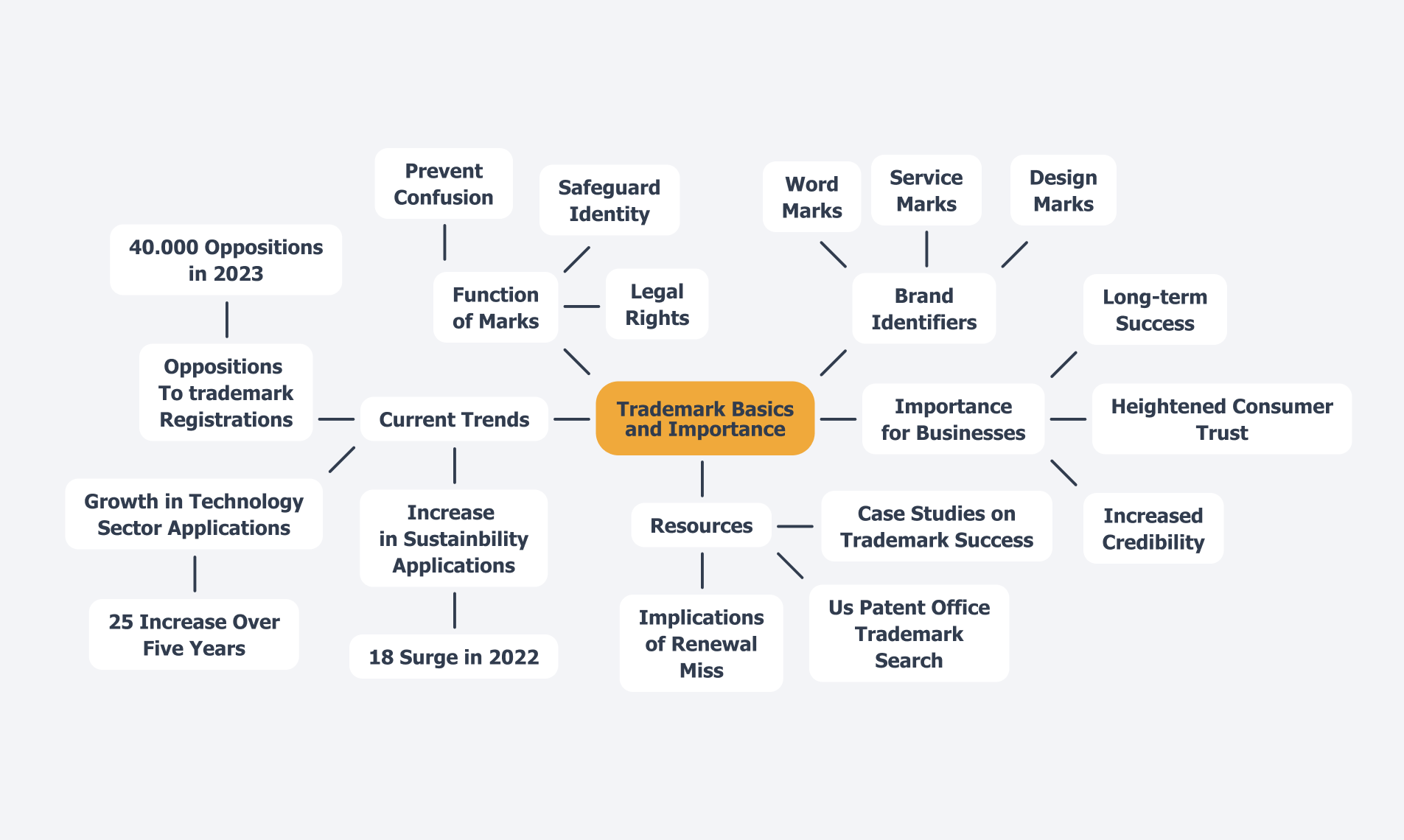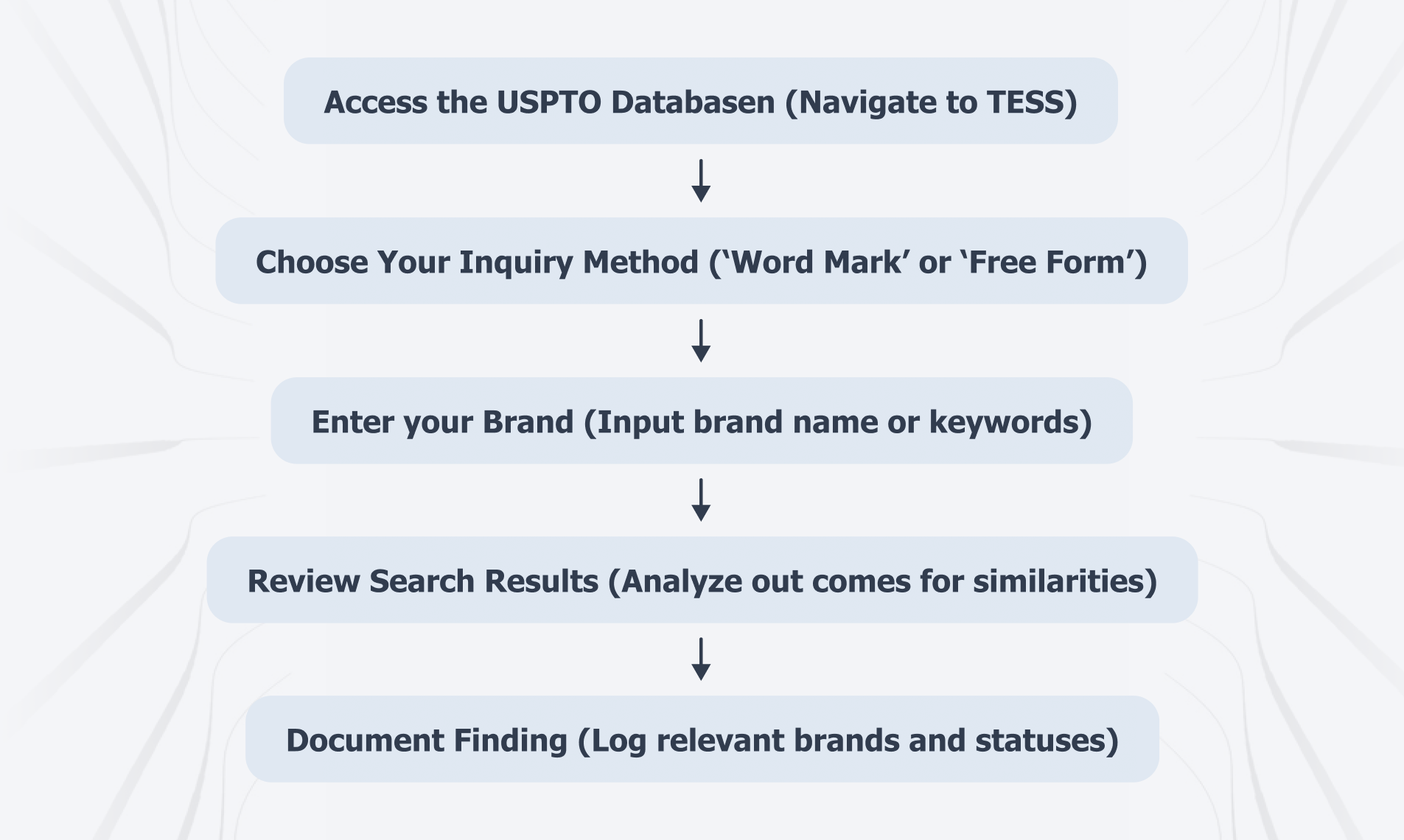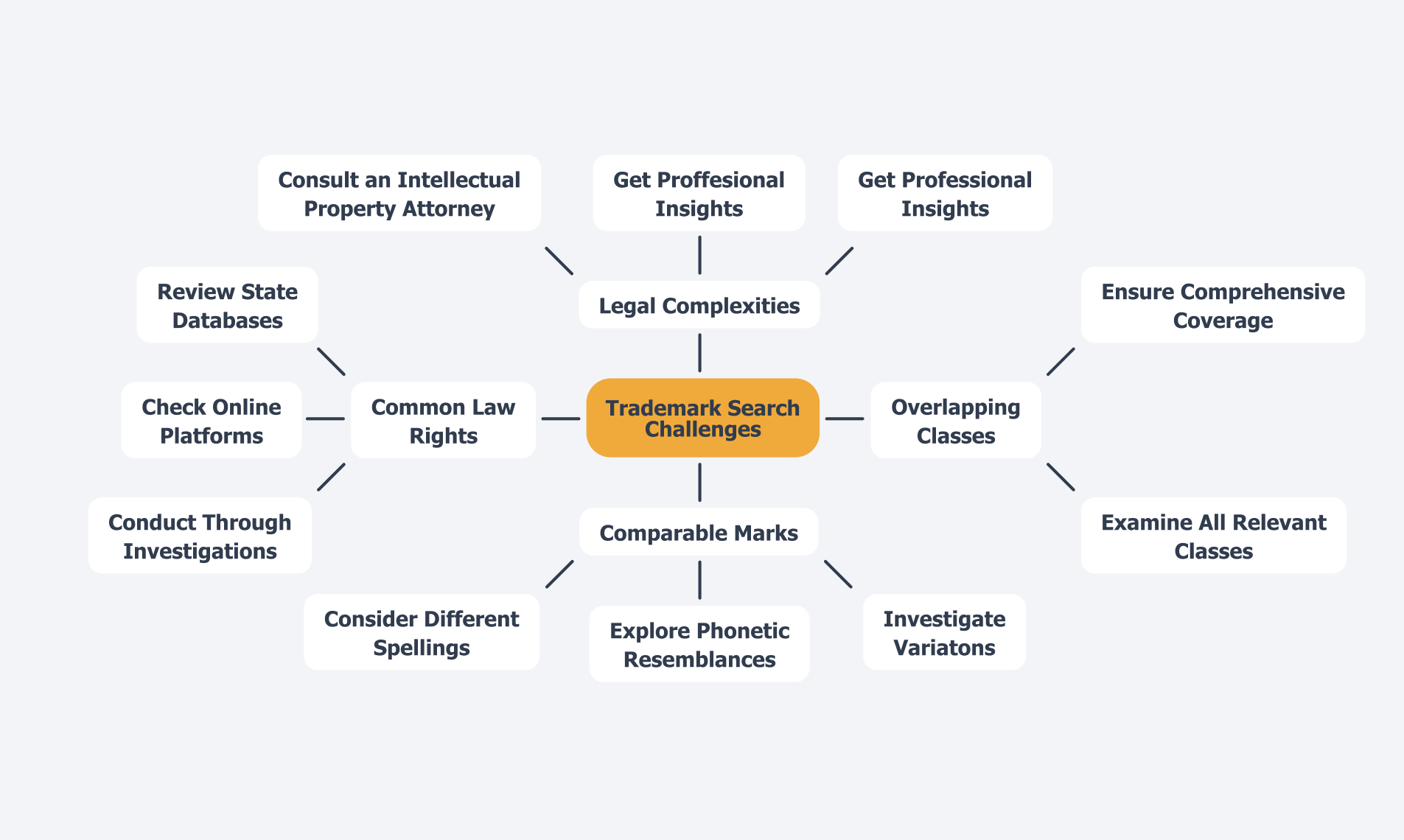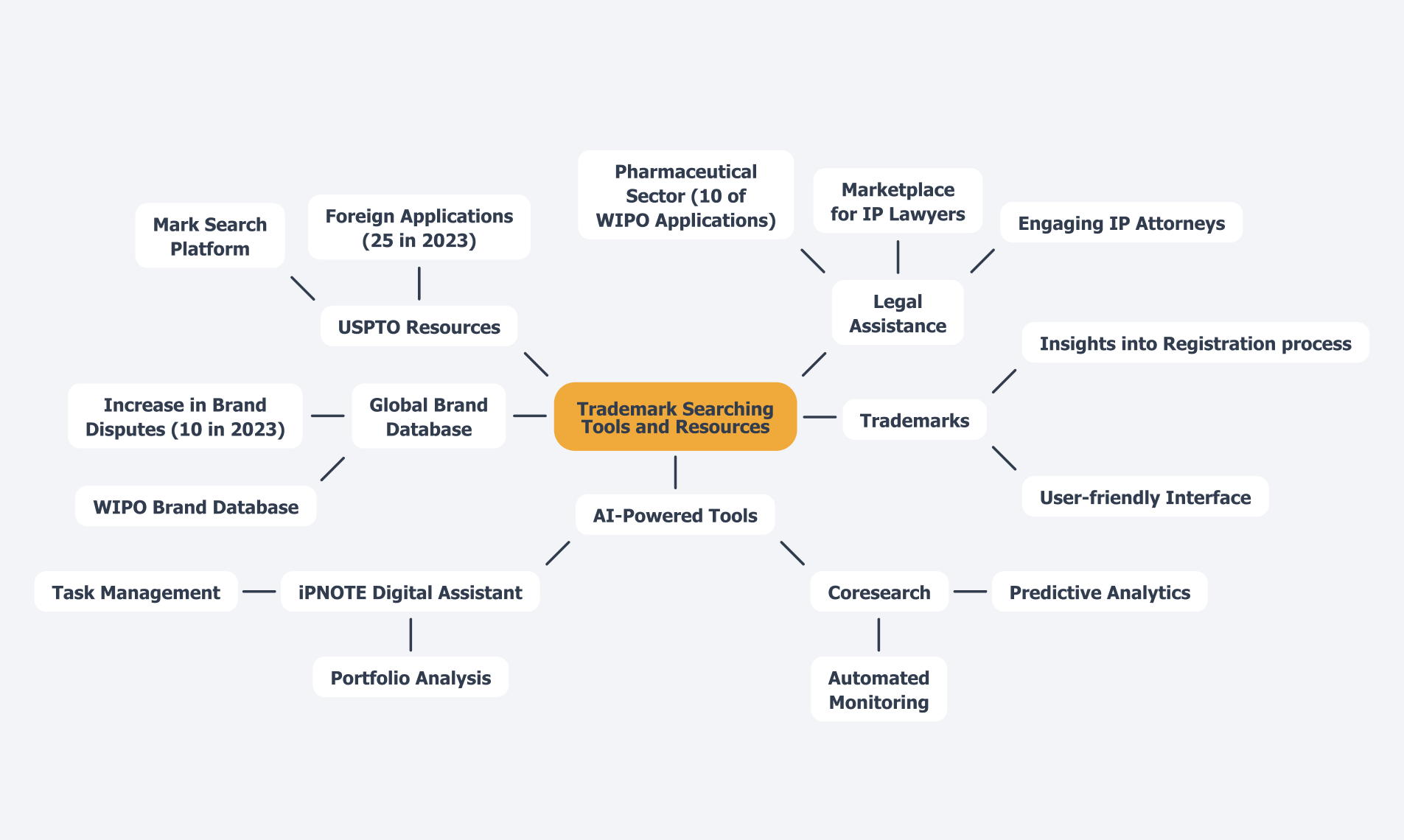Overview
This article delineates four essential steps for executing a successful trademark search with the US Patent Office. These steps encompass:
- Accessing the USPTO database
- Selecting an inquiry method
- Entering brand information
- Reviewing search results
Each step is bolstered by practical advice and relevant statistics, underscoring the necessity of meticulous research to avert potential conflicts and significantly enhance the likelihood of successful trademark registration.
Introduction
In an increasingly competitive business landscape, understanding the significance of trademarks is paramount for any organization aiming to establish a robust brand identity. Trademarks not only serve as unique identifiers for products or services but also play a crucial role in fostering consumer trust and loyalty.
As companies navigate the complexities of trademark registration, they encounter a myriad of challenges, from identifying potential conflicts to conducting thorough searches. This article delves into the essentials of trademark basics, offers step-by-step guidance for conducting effective trademark searches, and highlights the tools and resources available to streamline the process.
With the right strategies in place, businesses can safeguard their intellectual property and enhance their market position in today’s dynamic environment.
Understand Trademark Basics and Importance
A brand serves as a distinctive sign, design, or expression that identifies and differentiates the products or services of one source from those of others. Understanding brand identifiers requires recognizing their various categories, such as word marks, design marks, and service marks.
These marks fulfill essential functions: they safeguard brand identity, prevent consumer confusion, and confer legal rights against infringement.
In 2025, the importance of brand identifiers for businesses is underscored by the fact that companies with registered brand names experience a significant boost in credibility and market position. For instance, companies that have secured brand protections frequently report heightened consumer trust and loyalty, which are vital for long-term success.
Notably, the number of applications related to environmental sustainability and green technologies surged by 18% in 2022, reflecting contemporary trends in brand protection. Additionally, the USPTO encountered 40,000 oppositions to brand applications in 2023, highlighting the competitive landscape and the necessity for companies to safeguard their intellectual assets.
Familiarizing oneself with brand fundamentals is crucial; resources such as the US Patent Office trademark search provide valuable insights into the application process and its benefits. Furthermore, understanding the implications of failing to renew registration is essential, as this can affect the rights associated with a brand. Specific examples of businesses that have effectively enhanced their credibility through trademark registration further illustrate the advantages of protecting brand identity.

Follow Step-by-Step Procedures for Conducting a Trademark Search
- Access the USPTO Database: Begin by navigating to the USPTO Trademark Electronic Search System (TESS), the essential platform for searching federal trademarks.
- Choose Your Inquiry Method: Select your preferred inquiry approach. For straightforward queries, use the ‘Word Mark’ option. For more detailed inquiries, choose the ‘Free Form’ option, which permits complex queries.
- Enter Your Brand: Input the brand name or relevant keywords into the query bar. To maximize your search results, consider using variations and synonyms of your trademark.
- Review Search Results: Carefully analyze the outcomes for brands that may be similar. Concentrate on the condition of each mark (whether it is active or inactive) and the related goods or services.
- Document Findings: Keep a comprehensive log of relevant brands, including their identification numbers and statuses. This documentation will be essential for directing your next actions in the registration process.
Statistics show that around 10% of marks register on the Supplemental Register, underscoring the importance of performing comprehensive inquiries to improve registration success rates. By conducting a thorough inquiry, candidates can enhance their chances for successful sign-ups related to the US Patent Office trademark search. The USPTO’s Case Files Dataset, which includes over 6.7 million applications and registrations, serves as a valuable resource during this process. It offers insights into brand features and prosecution occurrences, enabling companies to make informed choices when utilizing TESS for brand inquiries. Furthermore, it is vital to be conscious of the consequences of missing renewal deadlines; neglecting to renew can endanger rights, highlighting the significance of remaining attentive in the management process.

Identify and Overcome Common Trademark Search Challenges
Navigating the intricacies of brand inspections in 2025 presents several typical obstacles that can impede the registration process. Consider the
following key issues and strategies to overcome them:
- Comparable Marks: The existence of symbols that closely mimic your suggested mark can complicate your inquiry. To reduce this, investigate variations of your brand, including phonetic resemblances and different spellings, to expand your scope.
- Overlapping Classes: Trademarks can be registered across multiple classes, which may lead to potential conflicts. It is crucial to examine all relevant classes that pertain to your goods or services to ensure comprehensive coverage.
- Common Law Rights: Numerous brand names are actively utilized but not registered, posing a risk during your inquiry. Conducting a thorough investigation beyond the US Patent Office trademark search—such as reviewing state databases and online platforms—can help uncover these common law rights and avoid potential disputes.
- Misleading Outcomes: Brand inquiry outcomes can often feature unrelated brands, resulting in confusion. To enhance accuracy, refine your search criteria by employing specific keywords and filters to eliminate unrelated results.
- Legal Complexities: The legal consequences of brand similarity can be intricate and challenging to navigate. Interacting with an intellectual property attorney can offer crucial insights and advice, ensuring that you grasp the implications of your findings and how to move forward effectively. As Vic Lin, a Patent and Trademark Attorney, aptly puts it, “Let’s get to work on your IP.”
In Q2 2024, roughly 66,443 local candidates submitted registrations, accounting for 58% of the overall requests. However, the proportion of submissions denied because of comparable marks remains a significant issue. To enhance your chances of successful enrollment, consider applying strategies derived from case studies that highlight the significance of comprehending the enrollment process and preparing applications that align with the requirements identified through a US Patent Office trademark search. For additional help, you may reach out to Sagacious IP concerning brand protection and associated services. By tackling these challenges in advance, companies can improve their brand investigation efforts and boost the chances of successful registration. Significantly, firms such as Tencent, LVMH, Amazon, Huawei, and Johnson & Johnson have been among the most prolific applicants in recent years, underscoring the competitive environment and the need for comprehensive examinations.

Utilize Tools and Resources for Enhanced Trademark Searching
To enhance your brand searching experience, leverage the following tools and resources:
- USPTO Resources: The USPTO’s Mark Search platform offers extensive querying capabilities and real-time access to mark request statuses, establishing itself as a crucial starting point for any mark inquiry. Notably, foreign applicants accounted for 25% of all brand registrations in 2023, underscoring the platform’s significance in the global brand landscape.
- Global Brand Database: The WIPO Global Brand Database is indispensable for companies operating on a global scale, enabling users to search for brand registrations across various jurisdictions. This tool’s importance is amplified by the 10% increase in brand disputes reported in 2023, reflecting a growing reliance on global brand databases.
- Trademarkia: This user-friendly platform simplifies the brand name inquiry process and provides insights into registration procedures, making it a favored choice among businesses.
- AI-Powered Tools: Advanced AI-driven platforms like Corsearch enhance brand inquiries through sophisticated algorithms and monitoring services. By 2025, these tools will be particularly vital, offering advantages such as predictive analytics and automated monitoring, ensuring users remain competitive. Additionally, iPNOTE’s AI-powered digital assistant consistently analyzes your intellectual property portfolio, setting reminders, managing tasks, and facilitating secure payments to streamline your IP management process.
- iPNOTE Global AI Trademark Search & Analysis Tool: Our AI-Powered Trademark Search Tool transforms the way you vet and protect your brand. In just 60 seconds, it scans global trademark databases—USPTO, EUIPO, WIPO and beyond—identifying identical or similar marks that could pose legal risks. You’ll receive a clear, actionable similarity score and a concise report highlighting potential conflicts, so you can decide your next steps with confidence. No more manual keyword juggling or inconsistent results: our intelligent assistant leverages natural-language understanding to interpret variants, translations, and stylized forms. Whether you’re a startup exploring a name or an enterprise monitoring ongoing filings, this end-to-end solution saves hours of research, reduces risk of costly objections or infringement disputes, and empowers you to move forward faster—without sacrificing accuracy.

Conclusion
Understanding trademarks is essential for any business aiming to solidify its brand identity and protect its intellectual property. The multifaceted role of trademarks cannot be overstated; they not only differentiate products and services but also enhance consumer trust and market positioning. As the landscape of trademark registration becomes increasingly competitive, companies must familiarize themselves with the fundamentals and the registration process to avoid pitfalls and ensure their brand is safeguarded.
Conducting thorough trademark searches is vital. Such searches help identify potential conflicts and inform businesses of existing marks that may impede their registration efforts. By following a systematic approach and utilizing available resources, such as the USPTO database and various AI-powered tools, businesses can significantly improve their chances of successful trademark registration. Furthermore, overcoming common challenges—like navigating similar trademarks and common law rights—requires proactive strategies and, at times, legal guidance.
As the importance of trademarks continues to rise, particularly in a global context, leveraging the right tools and resources becomes imperative.
By investing in comprehensive trademark searches and legal support, businesses not only protect their brand identity but also position themselves for long-term success in a competitive marketplace. The proactive management of trademarks will ultimately serve as a foundation for building trust, loyalty, and recognition among consumers in an ever-evolving business environment.
Secure Your Brand Identity with Smart Trademark AI Search Solutions. Start now with iPNOTE to simplify your trademark registration and protect your intellectual property.
Frequently Asked Questions
What is a brand and what are its key functions?
A brand is a distinctive sign, design, or expression that identifies and differentiates the products or services of one source from those of others.
Its key functions include safeguarding brand identity, preventing consumer confusion, and conferring legal rights against infringement.
Why are brand identifiers important for businesses in 2025?
In 2025, registered brand names significantly boost a company’s credibility and market position. Companies with brand protections often report increased consumer trust and loyalty, which are essential for long-term success.
What trends are currently influencing brand protection?
There has been an 18% surge in applications related to environmental sustainability and green technologies in 2022. Additionally, the USPTO faced 40,000 oppositions to brand applications in 2023, indicating a competitive landscape for brand protection.
How can businesses familiarize themselves with brand fundamentals?
Businesses can familiarize themselves with brand fundamentals by utilizing resources such as the US Patent Office trademark search, which provides valuable insights into the trademark application process and its benefits.
What are the consequences of failing to renew trademark registration?
Failing to renew trademark registration can adversely affect the rights associated with a brand, potentially leading to loss of legal protections.
Can you provide examples of businesses enhancing credibility through trademark registration?
The article mentions specific examples of businesses that have effectively enhanced their credibility through trademark registration, illustrating the advantages of protecting brand identity.






